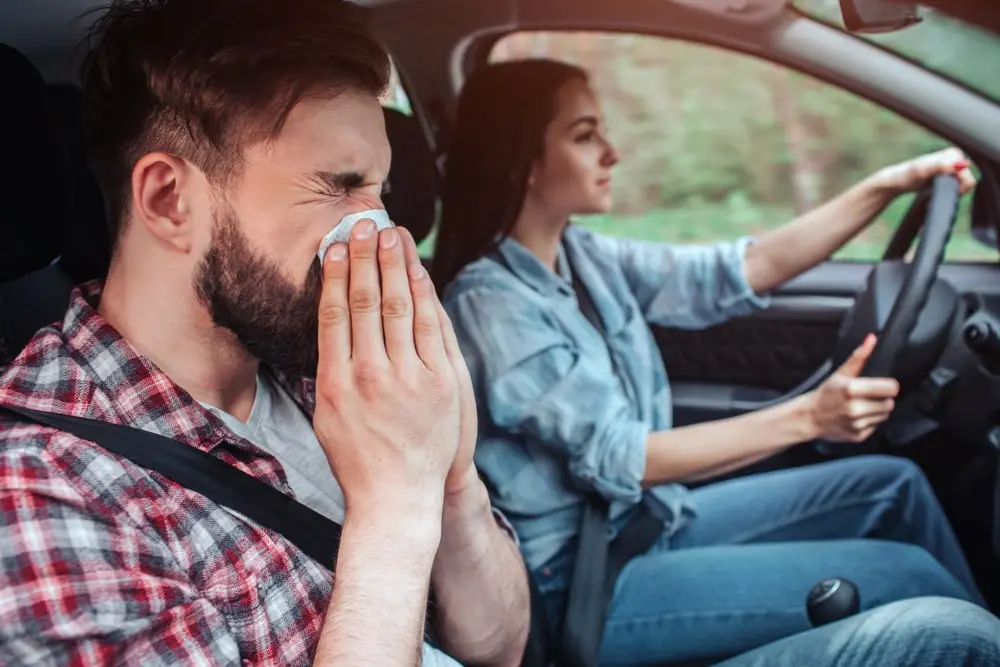When your body encounters an allergen — like pollen or pet dander — your immune system sees it as a foreign invader. This sets off an allergic reaction response and immune cells start to release histamine to fight off the allergen. These histamines are also responsible for causing those pesky allergic reaction symptoms.1
You may also be wondering, how long do allergies last? The short answer is as long as you are in contact with an allergen. For example, seasonal allergies — which are common during the spring — can last around two to three weeks per allergen.2 The longer the allergen is in the air, the longer your allergies will last.
Common Symptoms of Allergies
Depending on the way your body reacts to an allergen, symptoms can range from mild to severe. Many people experience mild to moderate allergy symptoms, which can often be treated at home. Some people, however, can experience severe allergic reactions to certain allergens which may require medical attention. Read on to learn about some different types of mild, moderate, and severe allergy symptoms.
Mild to Moderate Allergy Symptoms
When you think of allergies, you probably think of how they affect your nose, throat, and eyes. These are common symptoms of mild to moderate allergies, and can include:5,6
Sore, itchy throat: an irritated, swollen throat that may make it painful to swallow
Runny nose and sneezing: tickling in the nose that causes sneezing; may also cause post-nasal drip or irritation in the back of the throat from mucus
Cough: a dry, persistent cough
Allergic reaction rash: can present as allergic eczema, hives, or contact dermatitis; most often forms as an itchy, red rash
Watery or itchy eyes: also known as allergic conjunctivitis, causes redness and inflammation of the tissues around your eyes4
Severe Allergic Reaction (Anaphylaxis)
In severe allergic reactions, a condition known as anaphylaxis can develop. In anaphylaxis, histamines are rapidly released and flood the body, causing it to go into anaphylactic shock. This causes blood pressure to suddenly drop and airways to close, making breathing difficult.7
This reaction typically develops within seconds to minutes of coming into contact with an allergen.8 You should seek immediate medical attention if you or someone near you begins to experience these symptoms. Knowing the signs of anaphylaxis and what to do can save a life.
Anaphylaxis symptoms can include:
Low blood pressure
Weak and rapid pulse
Itchy skin or hives
Pale or flushed skin
Diarrhea, nausea, or vomiting
Dizziness or fainting
Tongue and throat swelling
Difficulty breathing due to constricted airways
It is important to note that BENADRYL® is not indicated for the treatment of anaphylaxis. If you have severe allergies, talk to your doctor about which medications are best for you.
Other Considerations
When it comes to experiencing allergy symptoms, these factors may put you at a higher risk for developing allergies in general:
Family history: if an immediate family member has allergies, you may be more likely to develop them too1
Asthma: for some people, the same triggers that set off allergy symptoms may also cause asthma symptoms3
Age: children are more likely to develop allergies than adults1
The type of allergen can also affect the type and severity of allergies. For example, allergies to certain foods and insect bites/stings have a higher potential of becoming severe, while seasonal allergies tend to be milder.4
What Causes Allergies?
There are many different types of allergens (substances that cause allergy symptoms), including insect bites and stings, airborne allergens, and foods that can cause your body to have an allergic reaction.9 We’re going to break down each category and the symptoms associated.
Insect Bites and Stings
Insect bites and stings cause an allergic reaction at the site of injury—in severe cases, it can cause a life-threatening reaction.10
Stinging insects include wasps, bees, yellow-jackets, hornets, and fire ants. When they sting, they inject venom into the skin which typically causes a red, swollen bump. In some people who are severely allergic to venom, it can cause anaphylaxis.10
Biting insects include mosquitoes, bedbugs, fleas, and certain kinds of flies. These bites can cause itching, redness, pain, and minor swelling.10
Airborne Allergens
Airborne allergens are present in the air and are breathed in. Some of the most common allergens include pollen, pet dander and mold.
While blooming flowers, trees, and grasses can be beautiful, they often release pollen into the air that can be irritating to the sinuses. Depending on the time of year, different allergens are present—it can also be tricky to tell the difference between seasonal and year-round allergies. You can read more about the differences here. Pollen allergy symptoms can include runny or stuffy nose, watery eyes, itchy nose, and sneezing.11
Although we love our pets, pet allergies can complicate things. Contrary to popular belief, pet hair is not typically the cause of allergies—instead, pet allergies are often caused by dander (skin flakes), saliva, and urine. When these allergens enter the air and are breathed in, they can cause a stuffy nose and inflamed eyes. If a pet has scratched you, the skin may become red and itchy.12
Latex
Latex is the protein found in natural rubber products made from the sap of the Brazilian rubber tree. For those allergic to latex, it can cause itchy, swollen skin at the point of contact. For those who are severely allergic, this can cause anaphylaxis, even from being in the same room near latex gloves or balloons.13
Food
Food allergies occur when your immune system recognizes food as a foreign invader, causing it to mount an allergy response. Common food allergens include:14
Eggs
Milk
Tree nuts/peanuts
Fish and shellfish
Wheat
Food allergy symptoms can include:
Swelling of the tongue, lips, and throat
Skin rashes or hives
Stomach pain, nausea, vomiting, or diarrhea
Shortness of breath or wheezing
In severe cases, anaphylaxis
Is It Allergies or Something Else?
Allergy symptoms can often overlap with other conditions, such as the common cold. To properly treat either, it's important to recognize the key differences. For more information on the differences between allergies and colds, read here.
How to Relieve Your Allergy Symptoms
The easiest way to reduce your allergic reactions is to avoid exposure to allergens. This may not always be possible, so try to limit it as much as possible. For relief from allergy symptoms, BENADRYL® offers several treatment options.
BENADRYL® is indicated for treating:
Itchy, watery eyes
Sneezing
Itchy throat
Runny nose
For relief from sinus congestion and pressure, BENADRYL® also offers BENADRYL® Allergy Plus Congestion.
To learn about more ways to treat and prevent allergies, visit our Treatment & Prevention page.
References
Mayo Clinic. Allergies. August 4, 2020. Accessed from: https://www.mayoclinic.org/diseases-conditions/allergies/symptoms-causes/syc-20351497
Asthma and Allergy Foundation of America. Rhinitis (Nasal Allergies). October 2015. Accessed from: https://www.aafa.org/rhinitis-nasal-allergy-hayfever/
Mayo Clinic. Allergies and asthma: They often occur together. May 14, 2021. Accessed from: https://www.mayoclinic.org/diseases-conditions/asthma/in-depth/allergies-and-asthma/art-20047458
Cleveland Clinic. Allergy Overview. November 30, 2020. Accessed from: https://my.clevelandclinic.org/health/diseases/8610-allergy-overview
American College of Allergy, Asthma, & Immunology. Allergy Symptoms. Accessed from: https://acaai.org/allergies/symptoms/
Cedars Sinai. Rhinitis. Accessed from: https://www.cedars-sinai.org/health-library/diseases-and-conditions/r/rhinitis.html
American College of Allergy, Asthma, & Immunology. Headaches. Accessed from: https://acaai.org/allergies/symptoms/headaches/
Mayo Clinic. Anaphylaxis. October 2, 2021. Accessed from: https://www.mayoclinic.org/diseases-conditions/anaphylaxis/symptoms-causes/syc-20351468
Asthma and Allergy Foundation of America. Types of Allergies. October 2015. Accessed from: https://aafa.org/allergies/types-of-allergies/
Asthma and Allergy Foundation of America. Insect Allergies. October 2015. Accessed from: https://www.aafa.org/insect-allergy/
Asthma and Allergy Foundation of America. Pollen Allergy. February 2022. Accessed from: https://www.aafa.org/pollen-allergy/
Asthma and Allergy Foundation of America. Pet Allergy: Are You Allergic to Dogs or Cats? October 2015. Accessed from: https://www.aafa.org/pet-dog-cat-allergies/
Asthma and Allergy Foundation of America. Latex Allergy. October 2015. Accessed from: https://www.aafa.org/latex-allergy/
Asthma and Allergy Foundation of America. What Is a Food Allergy? October 2015. Accessed from: https://www.aafa.org/food-allergies/


